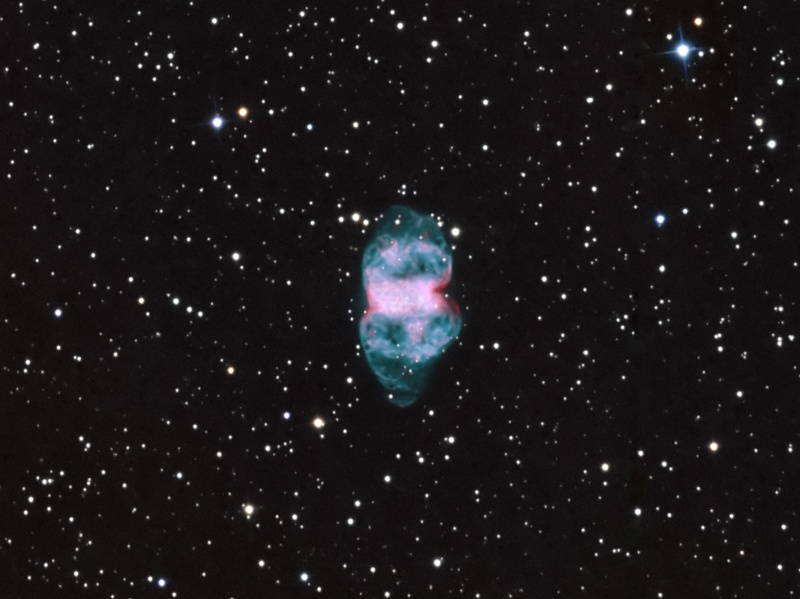
|
Credit & Copyright: Don Goldman
Explanation:
Also known by the popular name the "Little Dumbbell Nebula",
M76 is
one of the fainter objects listed in Charles Messier's 18th century
Catalog of
Nebulae and Star Clusters.
Like its better-known namesake M27
(the Dumbbell Nebula), M76 is recognized
as a planetary
nebula - a gaseous shroud cast off by a
dying sunlike star.
The nebula itself is thought to be shaped more like a donut, its
central box-like appearance
due to our nearly edge-on view.
Gas expanding more rapidly away from the donut hole produces the
more extensive, far flung material in
this remarkable image
that uses narrow-band
filters to highlight the
emission from hydrogen (in red) and
oxygen atoms (in greenish blue).
In particular, complex oxygen emission features are seen
above and below the main nebula to a degree not detected
in most images of M76.
Distance estimates place M76 about 3 to 5 thousand light-years away
toward the heroic constellation
Perseus,
making the nebula over a
light-year in diameter.
|
January February March April May June July August September October November December |
| ||||||||||||||||||||||||||||||||||||||||||||||||
NASA Web Site Statements, Warnings, and Disclaimers
NASA Official: Jay Norris. Specific rights apply.
A service of: LHEA at NASA / GSFC
& Michigan Tech. U.
Based on Astronomy Picture
Of the Day
Publications with keywords: M 76 - planetary nebula - narrow band filter
Publications with words: M 76 - planetary nebula - narrow band filter
See also:
- APOD: 2025 August 31 B NGC 7027: The Pillow Planetary Nebula
- APOD: 2025 August 22 B A Tale of Two Nebulae
- APOD: 2025 August 5 B NGC 6072: A Complex Planetary Nebula from Webb
- APOD: 2025 July 29 B A Helix Nebula Deep Field
- APOD: 2025 July 13 B Planetary Nebula Mz3: The Ant Nebula
- APOD: 2025 June 9 B Between Scylla and Charybdis: A Double Cosmic Discovery
- APOD: 2025 May 14 B NGC 1360: The Robins Egg Nebula
